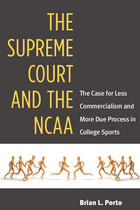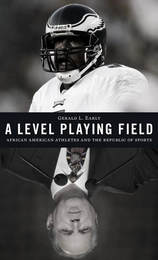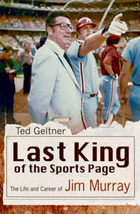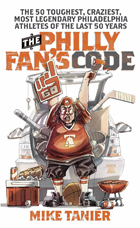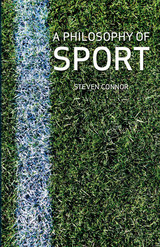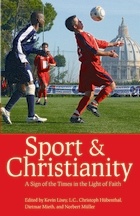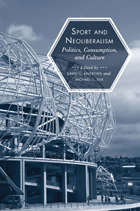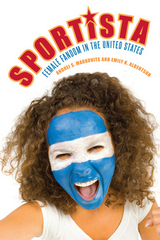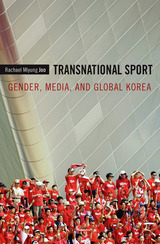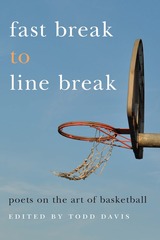SportsCollection by CRD (10 items)It is a sporting time of the year. Includes the following tags:
Athletes, Basketball, Christian Living, Cross-cultural studies, Editors, Journalists, Publishers, Judicial Branch, Media, Neoliberalism, Philadelphia, Poets, Republic, Sociological aspects, Sport, Times, United States. Supreme Court
See More
|
The Supreme Court and the NCAA
by Brian Porto
University of Michigan Press, 2013
Two Supreme Court decisions, NCAA v. Board of Regents (1984) and NCAA v. Tarkanian (1988), have shaped college sports by permitting the emergence of a supercharged commercial enterprise with high financial stakes for institutions and individuals, while failing to guarantee adequate procedural protections for persons charged with wrongdoing within that enterprise. Brian L. Porto examines the conditions that led to the cases, the reasoning behind the justices' rulings, and the consequences of those rulings. Arguing that commercialized college sports should be compatible with the goals of higher education and fair to all participants, Porto suggests that the remedy is a federal statute. His proposed College Sports Legal Reform Act would grant the NCAA a limited "educational exemption" from the antitrust laws, enabling it to enhance academic opportunities for athletes. The Act would also afford greater procedural protections to accused parties in NCAA disciplinary proceedings. Porto's prescription for reform in college sports makes a significant contribution to the debate about how best to address perennial problems in college sports such as cost containment, access to a meaningful education for athletes, and fairness in rule enforcement.
1
|
A Level Playing Field
by Gerald L. Early
Harvard University Press, 2011
As Americans, we believe there ought to be a level playing field for everyone. Even if we don’t expect to finish first, we do expect a fair start. Only in sports have African Americans actually found that elusive level ground. But at the same time, black players offer an ironic perspective on the athlete-hero, for they represent a group historically held to be without social honor.
2
|
Last King of the Sports Page
by Ted Geltner
University of Missouri Press, 2012
Part crusader, part comedian, Jim Murray was a once-in-a-generation literary talent who just happened to ply his trade on newsprint, right near the box scores and race results. During his lifetime, Murray rose through the ranks of journalism, from hard-bitten 1940s crime reporter, to national Hollywood correspondent, to the top sports columnist in the United States. In Last King of the Sports Page: The Life and Career of Jim Murray, Ted Geltner chronicles Jim Murray’s experiences with twentieth-century American sports, culture, and journalism. At the peak of his influence, Murray was published in more than 200 newspapers. From 1961 to 1998, Murray penned more than 10,000 columns from his home base at the Los Angeles Times. His offbeat humor and unique insight made his column a must-read for millions of sports fans. He was named Sportswriter of the Year an astounding fourteen times, and his legacy was cemented when he became one of only four writers to receive the prestigious Pulitzer Prize for coverage of sports. Geltner now gives readers a first look at Murray’s personal archives and dozens of fresh interviews with sports and journalism personalities, including Arnold Palmer, Mario Andretti, Kareem Abdul-Jabbar, Yogi Berra, Frank Deford, Rick Reilly, Dan Jenkins, Roy Firestone, and many more. Throughout his life, Murray chronicled seminal events and figures in American culture and history, and this biography details his encounters with major figures such as William Randolph Hearst, Henry Luce, Marilyn Monroe, Marlon Brando, John Wayne, Mickey Mantle, Muhammad Ali, and Tiger Woods. Charming and affecting moments in Murray’s career illustrate the sportswriter’s knack for being in on the big story. Richard Nixon, running for vice president on the Eisenhower ticket in 1952, revealed to Murray the contents of the “Checkers” speech so it could make the Time magazine press deadline. Media mogul Henry Luce handpicked Murray to lead a team that would develop Sports Illustrated for Time/Life in 1953, and when terrorists stormed the Olympic village at the 1972 Munich games, Murray was one of the first journalists to report from the scene. The words of sports journalist Roy Firestone emphasize the influence and importance of Jim Murray on journalism today: “I’ll say without question, I think Jim Murray was every bit as important of a sports writer—forget sport writer—every bit as important a writer to newspapers, as Mark Twain was to literature.” Readers will be entertained and awed by the stories, interviews, and papers of Jim Murray in Last King of the Sports Page.
3
|
The Philly Fan's Code
by Mike Tanier
Temple University Press, 2011
Face it: Philadelphia athletes are often as tough as their fans are passionate. How else to explain the rabid appeal of the bone-crunching Broad Street Bullies? Chuck Bednarik was one of the looniest tunes in Philadelphia sports history, but fuggedabout him. In The Philly Fan's Code, New York Times sportswriter Mike Tanier provides fun and opinionated essays that evaluate the 50 greatest, toughest, and most eccentric legends of Philly sports since Concrete Charlie hung up his cleats. Using his own "rubric" to calculate the impact of each athlete, Tanier ranks well-adjusted players like Mark Howe alongside both unpredictable athletes like Brad Lidge—who followed an almost perfect season with a 162-game catastrophe—and quirky ones, such as Wilt Chamberlain, who may be better known for bragging about his sexual conquests than for scoring 100 points in a game. And let's not forget our visitor from Planet Lovetron… Then there are the real wild cards-players like Terrell Owens, who does sit-ups in his driveway and whose impact—for better or worse— outlasted the few actual games he played for the Eagles. As for Tanier's choice for the No. 1 toughest, craziest, most legendary player, well, you'll have to read the book to see if you agree. Whether you do or don't, The Philly Fan's Code will provide hours of debates and memories of who our toughest sports heroes were—or weren't.
4
|
A Philosophy of Sport
by Steven Connor
Decommissioned Books from multiple publishers, 2011
While previous writing on the philosophy of sport has tended to see sport as a kind of testing ground for philosophical theories devised to deal with other kinds of problems—of ethics, aesthetics, or logical categorization—here Steven Connor offers a new philosophical understanding of sport in its own terms. In order to define what sport essentially is and means, Connor presents a complete grammar of sport, isolating and describing its essential elements, including the characteristic spaces of sport, the nature of sporting time, the importance of sporting objects like bats and balls, the methods of movement in sport, the role of rules and chance, and what it really means to cheat and to win. Defined as games that involve bodily exertion and exhaustion, sports simultaneously require constraint and the ability to overcome it. Sport, argues Connor, is a fundamental feature of modern humans. It is shown to be one of the most powerful ways in which we negotiate the relationship between the human and natural worlds. Encompassing a huge range of different sports, and enlisting the help of Hegel, Freud, Wittgenstein, Heidegger, Adorno, Sartre, Ayer, Deleuze, and Serres, A Philosophy of Sport will inform, surprise, and delight thoughtful athletes and sporty philosophers alike.
5
|
Sport and Christianity
by Kevin Lixey
Catholic University of America Press, 2012
Sport and Christianity explores the connections between these two seemingly disparate phenomena. It reflects on what the fascination for sport reveals about the human person and to what degree sporting activities are compatible with, and can even advance, the church's mission.
See More
6
|
Sport and Neoliberalism
edited by David L. Andrews
by Michael L Silk Temple University Press, 2012
Offering new approaches to thinking about sports and political ideologies, Sport and Neoliberalism explores the structures, formations, and mechanics of neoliberalism. The editors and contributors to this original and timely volume examine the intersection of sport as a national pastime and also an engine for urban policy—e.g., stadium building—as well as a powerful force for influencing our understanding of the relationship between culture, politics, and identity. Sport and Neoliberalism examines the ways the neoliberal project creates priorities for civic society and how, in effect, it turns many aspects of sport into a vehicle of public governance. From the relationship between sport and the neo-liberal state, through the environmental dimensions of neo-liberal sport, to the political biopolitics of obesity, the essays in this volume explore the ways in which the “logics” of neoliberalism are manifest as powerful public pedagogies through the realm of popular culture. Contributors include: Michael Atkinson, Ted Butryn, C. L. Cole, Norman Denzin, Grant Farred, Jessica Francombe, Caroline Fusco, Michael D. Giardina, Mick Green, Leslie Heywood, Samantha King, Lisa McDermott, Mary G. McDonald, Toby Miller, Mark Montgomery, Joshua I. Newman, Jay Scherer, Kimberly S. Schimmel, and Brian Wilson In the series Sporting, edited by Amy Bass
7
|
Sportista
by Andrei S. Markovits and Emily Albertson
Temple University Press, 2012
The typical female sports fan remains very different from her male counterparts. In their insightful and engaging book, Sportista, Andrei S. Markovits and Emily Albertson examine the significant ways many women have become fully conversant with sports—acquiring a knowledge of and passion for them as a way of forging identities that until recently were quite alien to women. In the series Politics, History and Social Change, edited by John C. Torpey
8
|
Transnational Sport
by Rachael Miyung Joo
Duke University Press, 2012
Based on ethnographic research in Seoul and Los Angeles, Transnational Sport tells how sports shape experiences of global Koreanness, and how those experiences are affected by national cultures. Rachael Miyung Joo focuses on superstar Korean athletes and sporting events produced for transnational media consumption. She explains how Korean athletes who achieve success on the world stage represent a powerful, globalized Korea for Koreans within the country and those in the diaspora. Celebrity Korean women athletes are highly visible in the Ladies Professional Golf Association. In the media, these young golfers are represented as daughters to be protected within the patriarchal Korean family and as hypersexualized Asian women with commercial appeal. Meanwhile, the hard-muscled bodies of male athletes, such as Korean baseball and soccer players, symbolize Korean masculine dominance in the global capitalist arena. Turning from particular athletes to a mega-event, Joo discusses the 2002 FIFA World Cup Korea/Japan, a watershed moment in recent Korean history. New ideas of global Koreanness coalesced around this momentous event. Women and youth assumed newly prominent roles in Korean culture, and, Joo suggests, new models of public culture emerged as thousands of individuals were joined by a shared purpose.
9
|
Fast Break to Line Break
edited by Todd Davis
Michigan State University Press, 2012
If baseball is the sport of nostalgic prose, basketball’s movement, myths, and culture are truly at home in verse. In this extraordinary collection of essays, poets meditate on what basketball means to them: how it has changed their perspective on the craft of poetry; how it informs their sense of language, the body, and human connectedness; how their love of the sport made a difference in the creation of their poems and in the lives they live beyond the margins. Walt Whitman saw the origins of poetry as communal, oral myth making. The same could be said of basketball, which is the beating heart of so many neighborhoods and communities in this country and around the world. On the court and on the page, this “poetry in motion” can be a force of change and inspiration, leaving devoted fans wonderstruck.
10
|
| Click here to go to the beginning. | ||||||||||
